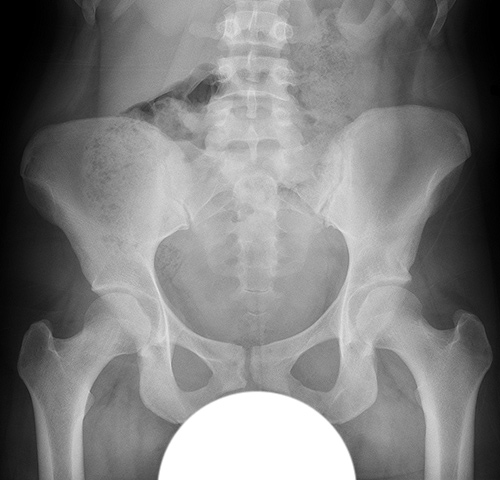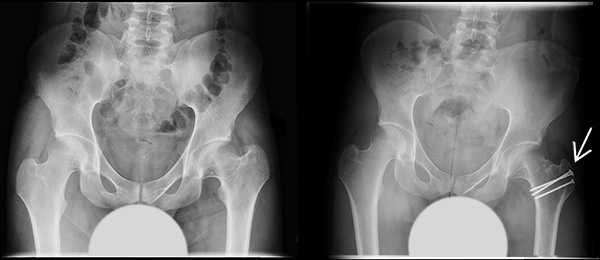Surgical Dislocation of the Hip: Surgery for Complex Conditions that Cause Hip Pain
Although many cases of hip pain in adults can be attributed to osteoarthritis, hip pain in younger patients is often caused by a range of conditions, including deformities that have been present since childhood. Many of these deformities can cause hip pain and be a cause of hip arthritis later. When surgical treatment is required, various surgical approaches may be effective. This includes hip arthroscopy – a minimally invasive surgery (through small incisions) that employs miniaturized instruments and a small camera to see the operative area. However, some patients (ages 10 to 45) with more complicated underlying conditions may be candidates for surgical hip dislocation, an open surgery that allows a surgeon to fully view the joint and more easily address complex anatomical issues.
What is surgical dislocation of the hip?
In surgical hip dislocation, the ball or head of the femur is separated out from its normal position of rest in the acetabulum. [Figure 1]
In contrast to hip dislocation that occurs as the result of severe trauma or worsening of a congenital deformity in the joint, in surgical hip dislocation the surgeon safely spares the surrounding muscles and preserves the blood supply to the hip joint.
“Surgical hip dislocation is just one of many approaches along with hip arthroscopy we use to address problems in the joint,” explains Ernest L. Sink, MD, Associate Attending Orthopedic Surgeon and Chief of the Hip Preservation Service at Hospital for Special Surgery (HSS). “However, it’s the only approach that gives you a 360° view of the affected area. Because the patient is anesthetized during the procedure, we can also observe the joint through a range of motion, giving us a better understanding of what is happening physically when he or she experiences pain.”

Figure 1. Anterior-to-posterior (front-to-back) X-ray image of the pelvis showing both hips. The ball of each femur rests in the acetabulum.
The technique for surgical dislocation of the hip was developed in 2000, under the direction of Reinhold Ganz, MD, Professor Emeritus at the University of Bern in Switzerland. Today, Dr. Sink and his colleagues employ Dr. Ganz’s technique to care for many young patients with complex hip conditions. The HSS Hip Preservation Service is one of a limited number of centers where a high volume of these procedures is performed.
What is surgical hip dislocation used for?
Hip conditions for which surgical dislocation of the hip may be recommended include:
- Femoroacetabular impingement (FAI), in which the femoral head and the acetabulum meet in such a way that range of motion in the joint is restricted; the underlying cause may be excess bone tissue on either the upper femur or the acetabulum, or when the femur and/or acetabulum are positioned at an abnormal angle.
- Other forms of impingement with complex deformities.
- Slipped capital femoral epiphysis (SCFE): a common hip disorder among early teenagers. This occurs when the cartilage growth plate (epiphysis) at the top of the femoral head slips out of place. In a child who has not reached skeletal maturity, the growth plate controls the way the top of the thighbone grows. Most often, SCFE occurs during a period of accelerated growth, shortly after the onset of puberty.
- Perthes disease, also known as Legg-Calvé-Perthes disease, is caused by idiopathic avascular necrosis of the femoral head, a condition in which the femoral head becomes damaged due to lack of blood supply. It is usually diagnosed in children between 4 and 12 years old.
- Tumors.
- Traumatic injuries with an osteochondral defect (a damaged area of bone and/or joint surface cartilage).
Surgical dislocation of the hip may also be recommended for individuals in whom a previous hip arthroscopy or other surgery has been unsuccessful.
Is surgical hip dislocation is right for my condition?
To determine whether a surgical dislocation is appropriate, the surgeon must listen to the patient’s symptoms and then to carefully assess radiographs (X-rays, MRIs and CT scans) and perform a thorough physical exam.
How does surgical hip dislocation work?
During the procedure, to gain access to the hip joint, the surgeon separates and retracts a piece of bone from the greater trochanter (the upper part of the femur), which is the attachment site for important muscles that completely surround the hip and facilitate its movement.
This method is called a greater trochanteric osteotomy. By using this approach, the surgeon can safely dislocate the hip, thereby protecting the blood vessels around the joint and leaving essential circulation and the surrounding muscles intact. The surgeon is then able to fully visualize and correct abnormalities of bone and soft tissues about the hip joint.
Commonly labral repair or reconstruction can be performed, impingement by the acetabulum or upper femur can be addressed. Deformities that had resulted from prior pediatric conditions such as SCFE or Perthes can be improved. Before closing the incision, the separated trochanteric bone fragment with the muscles is securely held in place with screws to maintain stability during healing. [Figure 2]

Figure 2. Anterior-to-posterior (front-to-back) X-ray images, before and after surgical dislocation of the left hip. X-ray on the right shows screw reattachment of the greater trochanter.
What is the recovery time for surgical hip dislocation?
Patients who undergo surgical hip dislocation at HSS can expect to spend between one to three nights in the hospital and to use crutches for a minimum of four to six weeks.
Physical therapy begins during hospitalization and includes instruction on maintaining limited, protected weight bearing, restrictions on joint motion during recovery, as well as muscle strengthening exercises. Outpatient physical therapy starts at six weeks once the bone is healing. Patients are monitored periodically during the first year following surgery to ensure that healing is progressing normally.
For many hip conditions, surgical hip dislocation provides the surgeon with the best opportunity to correct deformity and create a more normal, stable, and pain-free hip.
Is surgical dislocation of the hip safe?
“Surgical hip dislocation is a technically demanding procedure,” Dr. Sink explains, “but when it is performed carefully, it is extremely safe. Moreover, our ability to perform surgical hip dislocation at HSS and treat the underlying conditions with this approach is enabling us to understand even more about the subtleties of what causes hip pain.” For patients considering the procedure, Dr. Sink adds that it’s always advisable to seek care at a specialized institution, where these surgeries are performed on a regular basis, such as HSS.
Updated: 3/16/2021
Interview summary by Nancy Novick
Authors
Chief, Hip Preservation Service, Hospital for Special Surgery
Attending Orthopedic Surgeon, Hospital for Special Surgery
